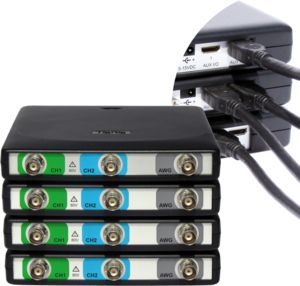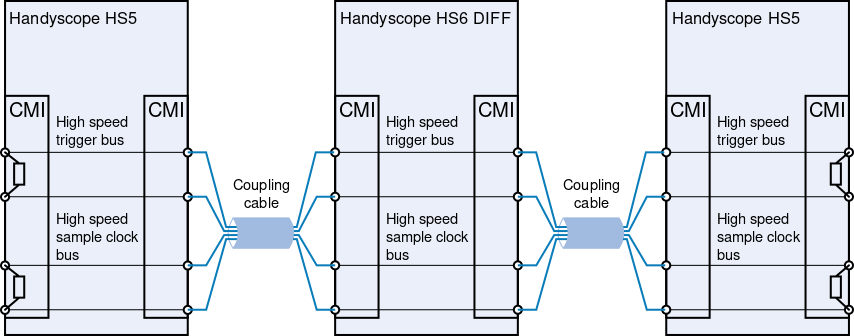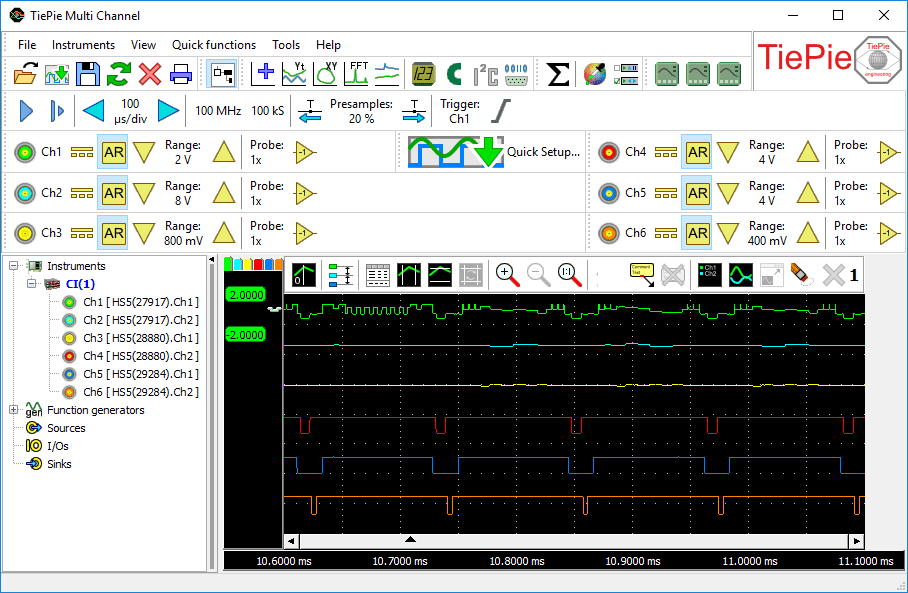
When two or four measurement channels are not sufficient, the WiFiScope series and Handyscope series of instruments offer a possibility to combine and synchronize multiple oscilloscopes to one single oscilloscope with many input channels. Just a coupling cable is required to combine the multiple instruments via their CMI interface to a single combined instrument with many channels. The maximum number of instruments is only limited by the number available USB ports. To couple the instruments, one TP-C50H Coupling cable CMI is required to couple two instruments.
Combining and synchronizing oscilloscopes
The unique CMI (Combine Multiple Instruments) synchronization interface provides an easy way to synchronize multiple oscilloscopes to one combined and fully synchronous oscilloscope. The CMI synchronization interface is standard available on the
Synchronizing WiFiScopes via the CMI interface is only available when they are connected via USB.
When WiFiScopes are connected via LAN or WiFi, or when the instruments are located far away from each other, synchronizing the instruments is possible via the Wireless Multi Instrument Synchronization Module WCMI.
The high speed sample clock bus takes care that each WiFiScope and/or Handyscope is fully synchronized to ensure that even at the highest sampling rate the instruments operate at the same sample clock (0 ppm clock error!). The high speed sample clock bus is automatically configured and terminated at the beginning and end of the bus.
Apart from a sample clock bus, the CMI also contains a trigger bus. This allows to trigger on any channel of the combined instrument, as well as any of the internal generator trigger sources, when instrument with a generator are combined. The high speed trigger bus is also automatically terminated with the correct impedance at the beginning and end of the bus.
The CMI synchronization interface supports automatic recognition of the instruments. It has built-in intelligence to detect the connections, so instruments can be connected to each other in random order. The connection order when combining multiple instruments is not important. Placing terminators and determining the proper connection order is not required!

Advantages of the CMI (Combine Multiple Instruments) synchronization interface are:
- automatic instrument recognition,
- automatic creation and termination of the high speed trigger bus,
- automatic creation and termination of the high speed sampling bus,
- automatic master/slave setting of the sampling clock bus.
When you need an 8, 16, 32 or even 128 channel oscilloscope or data recorder, borrow the Handyscopes of your colleagues and combined them using the synchronization CMI interface to a large instrument, where all channels are measured fully synchronized. When ready, return the Handyscopes to your colleagues and anyone can use his own Handyscope again. The purchase of an expensive and cumbersome multi-channel oscilloscope or data logger that is not used every day is unnecessary due to the CMI synchronization interface. The Handyscope can therefore easily be used for a temporary multi-channel instrument when necessary.
To couple the instruments, one TP-C50H Coupling cable CMI is required to couple two instruments. When more than two instruments need to be coupled multiple TP-C50H Coupling cable CMIs are required, to daisy chain the instruments to each other.
Combining and synchronizing the instruments is fully automatic. When the Multi Channel oscilloscope software is started, the coupled instruments are recognized and combined to a large instrument. Combining e.g. four Handyscope HS5s results in a unique 8 channel 12 bit 500 MSa/s oscilloscope. All channels of the four units sample fully synchronized and can be controlled in one application. The user gets one oscilloscope. Coupling of e.g. five Handyscope HS6 DIFFs gives an ultimate and unique 20 channel 12 bit 1 GSa/s oscilloscope!

The video shows how to combine and synchronize multiple oscilloscopes using the unique TiePie engineering Combine Multiple Instruments synchronization interface, where all channels are sampled using the same clock, with 0 ppm clock error, and shown together in one graph.

